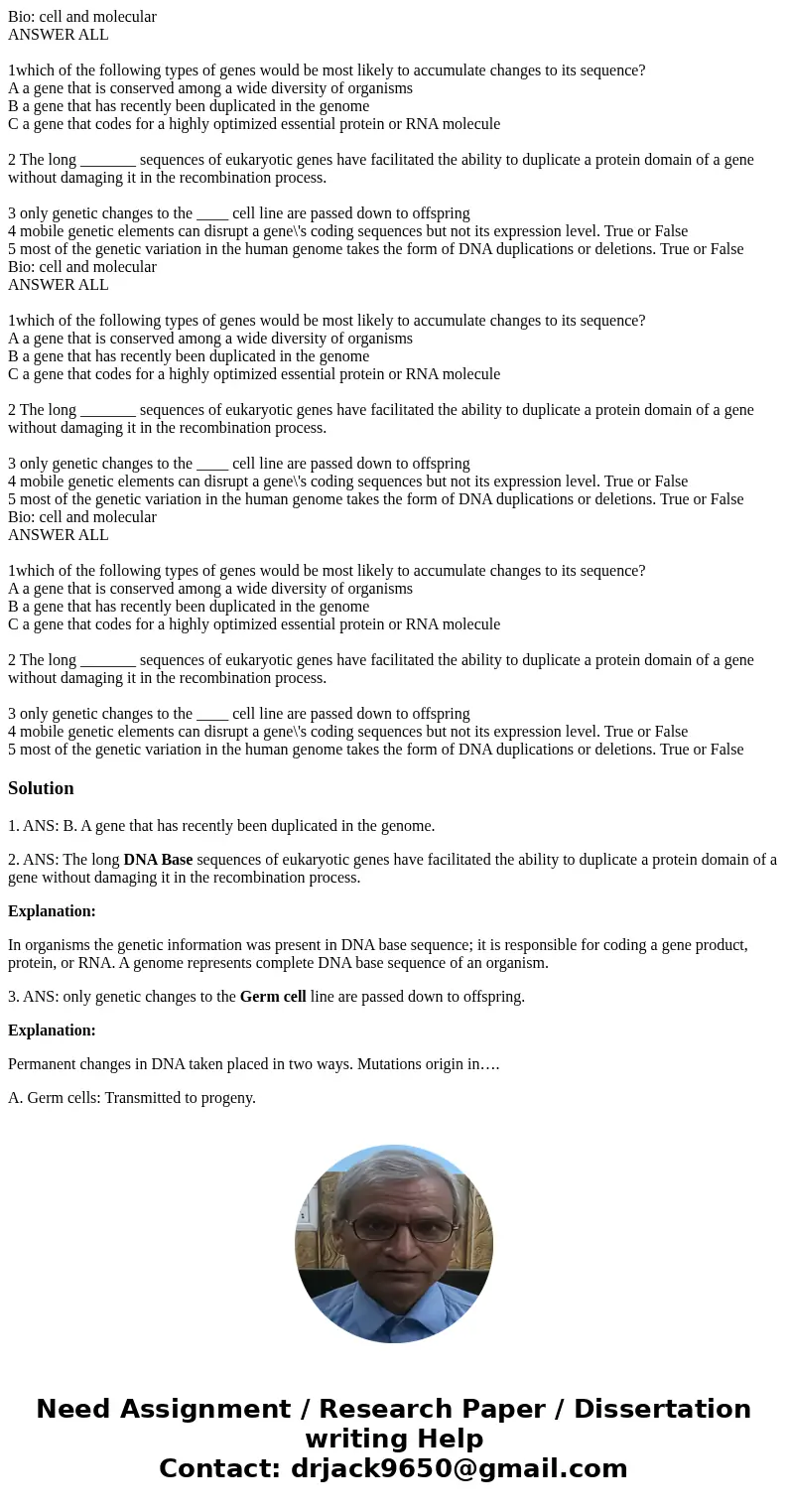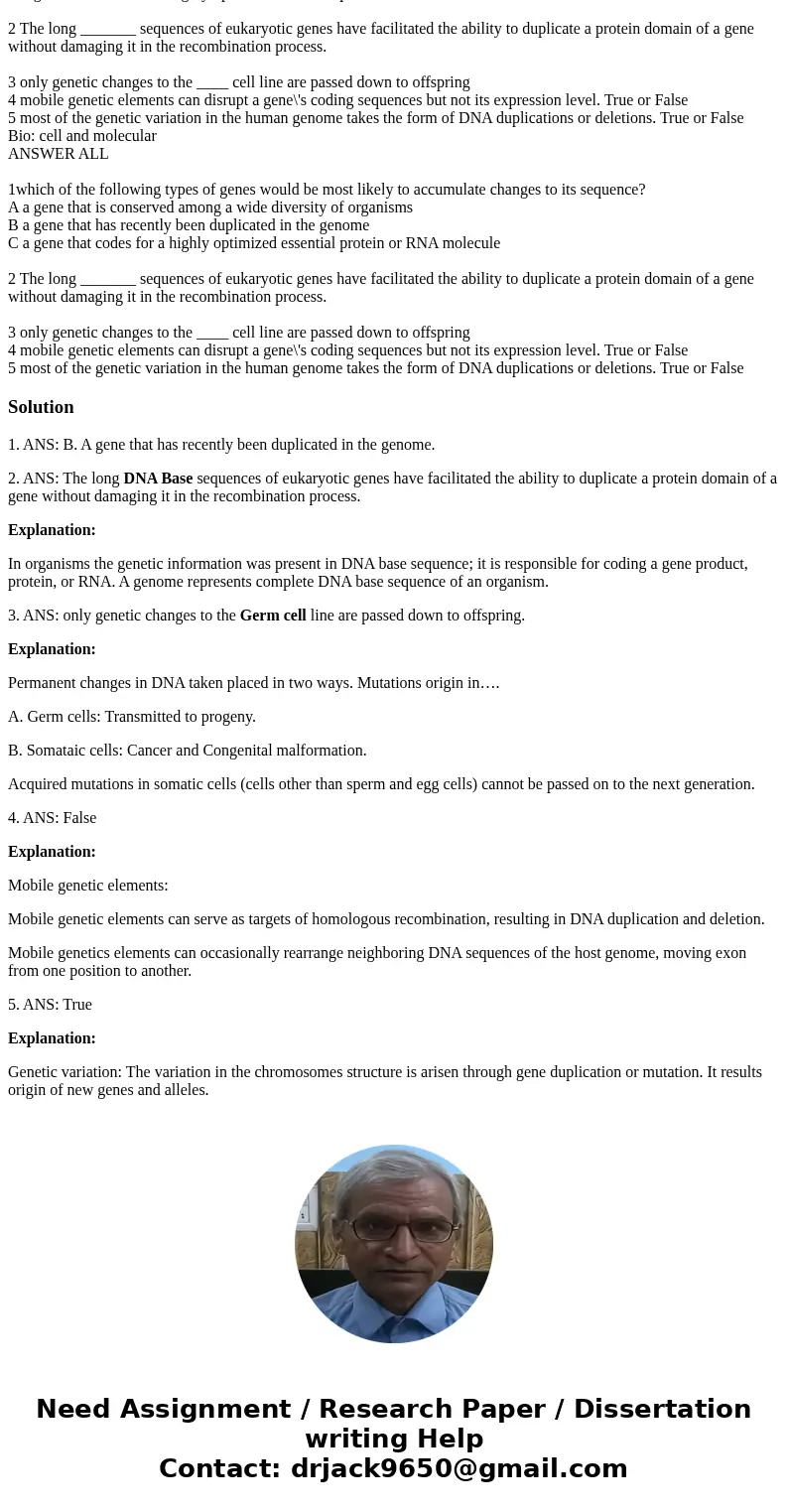Bio: cell and molecular
ANSWER ALL
1which of the following types of genes would be most likely to accumulate changes to its sequence?
A a gene that is conserved among a wide diversity of organisms
B a gene that has recently been duplicated in the genome
C a gene that codes for a highly optimized essential protein or RNA molecule
2 The long _______ sequences of eukaryotic genes have facilitated the ability to duplicate a protein domain of a gene without damaging it in the recombination process.
3 only genetic changes to the ____ cell line are passed down to offspring
4 mobile genetic elements can disrupt a gene\'s coding sequences but not its expression level. True or False
5 most of the genetic variation in the human genome takes the form of DNA duplications or deletions. True or False
Bio: cell and molecular
ANSWER ALL
1which of the following types of genes would be most likely to accumulate changes to its sequence?
A a gene that is conserved among a wide diversity of organisms
B a gene that has recently been duplicated in the genome
C a gene that codes for a highly optimized essential protein or RNA molecule
2 The long _______ sequences of eukaryotic genes have facilitated the ability to duplicate a protein domain of a gene without damaging it in the recombination process.
3 only genetic changes to the ____ cell line are passed down to offspring
4 mobile genetic elements can disrupt a gene\'s coding sequences but not its expression level. True or False
5 most of the genetic variation in the human genome takes the form of DNA duplications or deletions. True or False
Bio: cell and molecular
ANSWER ALL
1which of the following types of genes would be most likely to accumulate changes to its sequence?
A a gene that is conserved among a wide diversity of organisms
B a gene that has recently been duplicated in the genome
C a gene that codes for a highly optimized essential protein or RNA molecule
2 The long _______ sequences of eukaryotic genes have facilitated the ability to duplicate a protein domain of a gene without damaging it in the recombination process.
3 only genetic changes to the ____ cell line are passed down to offspring
4 mobile genetic elements can disrupt a gene\'s coding sequences but not its expression level. True or False
5 most of the genetic variation in the human genome takes the form of DNA duplications or deletions. True or False
1. ANS: B. A gene that has recently been duplicated in the genome.
2. ANS: The long DNA Base sequences of eukaryotic genes have facilitated the ability to duplicate a protein domain of a gene without damaging it in the recombination process.
Explanation:
In organisms the genetic information was present in DNA base sequence; it is responsible for coding a gene product, protein, or RNA. A genome represents complete DNA base sequence of an organism.
3. ANS: only genetic changes to the Germ cell line are passed down to offspring.
Explanation:
Permanent changes in DNA taken placed in two ways. Mutations origin in….
A. Germ cells: Transmitted to progeny.
B. Somataic cells: Cancer and Congenital malformation.
Acquired mutations in somatic cells (cells other than sperm and egg cells) cannot be passed on to the next generation.
4. ANS: False
Explanation:
Mobile genetic elements:
Mobile genetic elements can serve as targets of homologous recombination, resulting in DNA duplication and deletion.
Mobile genetics elements can occasionally rearrange neighboring DNA sequences of the host genome, moving exon from one position to another.
5. ANS: True
Explanation:
Genetic variation: The variation in the chromosomes structure is arisen through gene duplication or mutation. It results origin of new genes and alleles.


 Homework Sourse
Homework Sourse